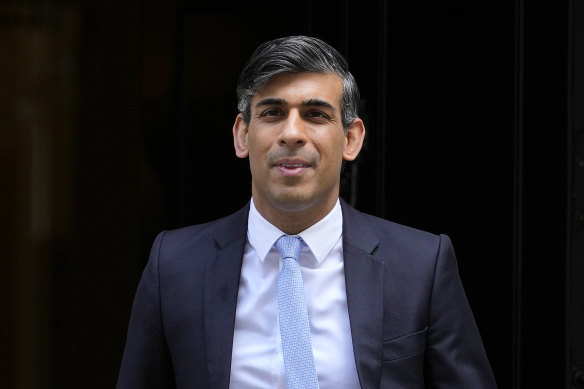
“To save face and to save expense, there has been a hiding of much of the truth,” it said.

British Prime Minister Rishi Sunak has vowed to pay further compensation to the victims’ families.Credit: AP
More than 26,000 people were infected with hepatitis C through blood transfusions from 1970 to 1991, the report found. Among those who received tainted blood products, about 1250 people were infected with HIV, including about 380 children; an additional 5000 developed a chronic form of hepatitis C.
“This disaster was no accident,” Brian Langstaff, a former High Court judge who led the inquiry, said at a news conference in London crowded with contamination victims and their families. They cheered and clapped as he laid bare what he said was a string of egregious failings by British health and government officials who “did not put patient safety first.”
“People put their trust in doctors and the government to keep them safe, and that trust was betrayed,” Langstaff said. “The NHS and successive governments compounded the agony by refusing to accept that wrong had been done.”
Victims of the blood contamination and their families expressed relief over the report’s findings but also anger that it had taken so long. Some victims died before the inquiry ended – or had even started – as did some of the officials who might have been held accountable.
Andy Evans, a longtime campaigner who was 13 when he discovered that a blood transfusion for his haemophilia had given him HIV, said he felt “validated and vindicated”.
“We’ve been gaslit for generations,” Evans said. “This report puts an end to that.”
Some of the failings identified in the report occurred before Sunak was even born, but Langstaff said that governments until recently displayed “institutional defensiveness” by playing down or denying past wrongdoings, even as infected patients continued to die.
In some cases, Langstaff said, documents were “deliberately and wrongly destroyed in an attempt to make the truth more difficult to reveal”.
The inquiry did not have the authority to recommend criminal prosecutions, and it was not immediately clear whether the report would lead to any.
“If there’s clear evidence and there is a pathway to that, then it’s obviously something the government will have to address,” John Glen, a British government official who has been in charge of matters related to the infected blood inquiry, told LBC radio Monday.
The scandal has its roots in the 1970s and 1980s, when thousands of patients were exposed to the contaminated blood. Some required transfusions after accidents, surgery or complications during childbirth.
Many others were patients with haemophilia, a genetic condition that prevents blood from clotting properly. At the time, many of them were provided with a treatment derived from blood plasma called Factor VIII that provided the missing protein that haemophiliacs need for their blood to clot.
The treatment was made using pools of plasma from thousands of donors, meaning that even a few tainted donations could contaminate an entire pool. (Later, synthetic clotting factor proteins were developed.)
The NHS imported some of the Factor VIII from the United States, where many donations were from prisoners or drug users who had been paid to donate blood – elevating the risk of contamination with HIV or hepatitis C.
For years, British government and health authorities insisted that the infections were inadvertent, that patients received the best available care and that screening for hepatitis C could not have been introduced any earlier.
But Langstaff said British authorities ignored early warning signs – some stretching back to the 1940s – that blood transfusions could transmit diseases such as hepatitis. They also failed to adequately screen high-risk donors, failed to inform patients of the risks and were slow to adopt new tests that were being used by other countries, he said.
The World Health Organisation as early as 1952 had identified how to reduce the risk of transmitting hepatitis through blood transfusion and blood products, for instance by carefully selecting donors and avoiding large donor pools, he said. But British authorities followed little to none of that advice, he added.
The report found that British authorities failed to secure a sufficient domestic supply of Factor VIII concentrates from the plasma of United Kingdom donors and, in 1973, authorised the import of blood products from the United States and from Austria – even though those treatments “were understood to be less safe than current domestic treatments for bleeding disorders”.
In some cases, victims were even used in medical trials without their consent. In others, diagnoses were delayed or withheld, leading patients to unknowingly infect their partners.
The inquiry panel – composed of legal professionals, investigators and civil servants – heard from people who were infected and their relatives and loved ones, medical and ethics experts, government officials, and politicians.
Previous inquiries and compensation offers had been deemed insufficient by victims and their families. In 2009, an independent report concluded that the tragedy could have been prevented if imports of blood from the United States had been halted but stopped short of blaming individual doctors or companies, and no one from the Department of Health was called to testify.
In 2015, an inquiry in Scotland prompted an apology from David Cameron, prime minister at the time, but the investigation was deemed unsatisfactory by victims and their families because it was unable to call witnesses outside of Scotland.
Other nations, including the US and Japan, have faced similar scandals.
In France, several senior health officials were convicted in 1992 on charges of distributing tainted blood, and the health minister at the time was convicted in 1999 of negligence. But he received no punishment, and two other top officials, including Laurent Fabius, prime minister at the time, were acquitted.
This article originally appeared in The New York Times.



























